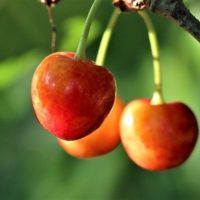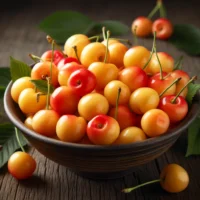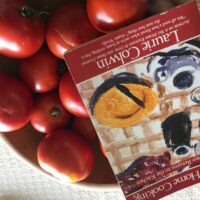Celebrate Sweetness: Happy Rainier Cherry Day!
Today, July 11, is National Rainier Cherry Day. The theme for this year’s celebration is “Cherish the Cherry Bliss.”
This delightful celebration is all about savoring the exquisite sweetness and unique flavor of Rainier cherries, a true gem of the fruit world.
Rainier cherries, a variety of sweet cherry, were first developed in 1952 at Washington State University by crossing the Bing and Van cherry varieties. Named after Mount Rainier, these cherries are renowned for their beautiful golden-yellow skin with a blush of red and their incredibly sweet, juicy flesh. 
Harvested primarily in Washington state, Rainier cherries have a relatively short season, typically June to August, making them a cherished summer treat.
Why We Love Rainier Cherries
- Exceptional Flavor: Rainier cherries are prized for their unique taste—a perfect balance of sweetness with a hint of tartness. Each bite is a burst of summer’s essence.
- Nutritional Benefits: These cherries are delicious and packed with nutrients. They are a great source of fiber, vitamin C, and antioxidants, which help fight inflammation and support overall health.
- A Good Night’s Sleep: Like their darker cherry cousins, Rainier cherries are a natural source of melatonin, a hormone that regulates sleep cycles. A handful of these cherries can be a delicious way to promote a restful night’s sleep.
- Versatility in the Kitchen: Whether enjoyed fresh, added to salads, incorporated into desserts, or made into preserves, Rainier cherries bring a touch of elegance and sweetness to any dish.
Ways to Celebrate Rainier Cherry Day
- Enjoy Fresh Rainier Cherries: The simplest way to celebrate is by indulging in a bowl of fresh Rainier cherries. Their sweet and juicy flavor is best enjoyed raw, making them a perfect snack on a warm summer day.

- Create Cherry-Inspired Recipes: Experiment with Rainier cherries in your kitchen. Try making a refreshing cherry salsa, a vibrant cherry salad, or a decadent cherry pie or cobbler. The possibilities are endless, and the results are always delicious.
- Host a Cherry Tasting Party: Invite friends and family over for a cherry-themed gathering. Offer a variety of cherry dishes, including fresh Rainier cherries, cherry-infused beverages, and cherry-based desserts. It’s a delightful way to share the love for this summer fruit.
- Create Cherry Cocktails: Mix up some refreshing cherry cocktails or mocktails. Muddle them into lemonades and sparkling water. A Rainier cherry mojito or a cherry sangria can be the perfect addition to your summer festivities or relaxing evening.
As you celebrate Rainier Cherry Day, take a moment to appreciate the simple pleasures of summer.
Here’s to a day filled with sweet, juicy bliss~
Much love,
Health Coach Carol
“Under a cherry tree, all burdens of life fly away!” – Mehmet Murat Ildan







